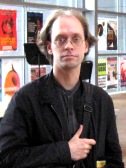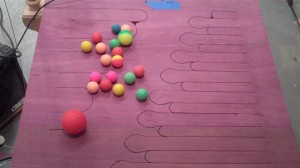 Many of our regular s21 readers should be familiar with Amsterdam’s own Samuel Vriezen, both as a visitor here on these pages, as well as a composer selected to be on both of our past s21-produced concerts. Samuel’s always been a highly active explorer, whether in his own or others’ music, poetry, concert production, cross-continent discussions with artists of all stripes, you name it. With a strong interest in Language Poetry, it’s not surprising that his explorations have led him to what I might call “Language Music”.
Many of our regular s21 readers should be familiar with Amsterdam’s own Samuel Vriezen, both as a visitor here on these pages, as well as a composer selected to be on both of our past s21-produced concerts. Samuel’s always been a highly active explorer, whether in his own or others’ music, poetry, concert production, cross-continent discussions with artists of all stripes, you name it. With a strong interest in Language Poetry, it’s not surprising that his explorations have led him to what I might call “Language Music”.
No composer could better typify this kind of piece than ex-pat American (and former Village Voice critic) Tom Johnson. For quite some time, Johnson’s own brand of ‘minimalism’ has produced a whole series of stunning pieces, often from the most basic and transparent idea and means. The beauty of Johnson’s work is that he’ll take some very simple starting concept or question and, without trying to finesse or “art it up”, follow the process all the way through in the most natural and even mundane fashion. What’s fascinating is how such a simple starting point can end up creating it’s own rich and absorbing musical experience.
Case in point: Johnson’s 1986 piece titled simply The Chord Catalog. The work consists of all 8178 chords you can play using the 13 tones of one full octave, from the 78 2-note chords up to the one 13-tone cluster. The progression unfolds on the piano with absolute regularity, both through the notes and through time. While this may sound dry as dust, what happens over time is a strange tension, anticipation, and eventually even a bit of rich disorientation. It’s also incredibly difficult to perform; Johnson himself had such a hard time mastering it that he was pretty sure there’d be no one to follow. But along came Samuel, who became enamoured enough with the piece to put in all the work necessary to not only master it, but to surpass the master in accuracy and speed.
And now there’s a chance for you to hear Samuel bring his performance of The Chord Catalog to our own shores. He’s winging his way across the pond to give two performances here: the first in Washington D.C. this Monday, October 26th at 7:30pm at Ward Recital Hall, Catholic University of America, 620 Michigan Ave. NE); the second in New York City on Wednesday, October 28th, 8:30PM at Roulette (20 Green St.).
The Concerts are titled “Chord Catalogues” because also on the bill is Samuel’s own 2006 piece Within Fourths/Within Fifths, a work that forms a kind of natural extension to the Johnson.
Just to complete the hat-trick, Samuel also has the world premiere of his piece Sept Germes Cristallins at a concert Friday, october 30, 8PM, presented by the Ensemble Lunatics At Large at the Mannes College of Music (Mannes College Concert Hall, 150 W. 85th St) in a bill that includes Chen Yi, György Kurtág, Ryan Brown, Luciano Berio, William Funk and John Harbison. About the new work, Samuel tells me it “was written at the request of the Flemish literary review, Deus Ex Machina, as a contribution for their Valéry issue. Given that I am a poet and a composer with some background in mathematics, the idea was that I would somehow respond musically to one of the fragments from Valéry’s Cahiers – the extraordinary and humungous collection of thoughts and notes that he diligently was penning down every single morning for many decades. I chose a brief text that compares a sudden memory to the sudden crystalization that can happen in an over-saturated solution, because it suggested musical textures to me. It’s a piece in which every musician has lots of freedoms, with the soprano in control of the pacing, and every now and then a sudden fractal canon crops up.”
So if you’re in any of those neighborhoods then, drop by for some truly astounding music, and say “hi” personally to one of the nicest minds I know (for an in-your-face Dutch guy, that is 😉 … ).
 Washington, D.C. readers may have noticed that the new music scene in the District has been exploding lately. This week brings another significant event when New York’s Cygnus Ensemble makes its Washington debut at the Library of Congress. The concert, part of a mini-residence by Cygnus at the Library, is presented as a tribute to legendary violinist and composer Fritz Kreisler. Rarely heard music by Kreisler from the Library’s Fritz Kreisler collection will be performed, featuring guest violinist Miranda Cuckson on Kreisler’s own Guarneri del Gesù violin.
Washington, D.C. readers may have noticed that the new music scene in the District has been exploding lately. This week brings another significant event when New York’s Cygnus Ensemble makes its Washington debut at the Library of Congress. The concert, part of a mini-residence by Cygnus at the Library, is presented as a tribute to legendary violinist and composer Fritz Kreisler. Rarely heard music by Kreisler from the Library’s Fritz Kreisler collection will be performed, featuring guest violinist Miranda Cuckson on Kreisler’s own Guarneri del Gesù violin.

 Many of our regular s21 readers should be familiar with Amsterdam’s own
Many of our regular s21 readers should be familiar with Amsterdam’s own